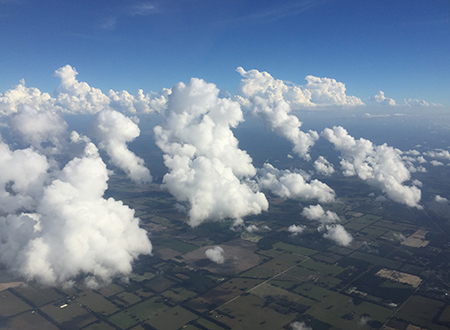Autopilot Experience on a Long RV-9A Trip
By Ian Brown, Editor
December 10, 2018 - Flying my RV down to Florida from Quebec has become an annual ritual. It’s about 11 hours of flying time so it can get to be a bit tiring, even with two pilots on board. I wrote an article for the October issue of Bits and Pieces last year and hadn’t honestly flown with the autopilot much after that. The basic idea was that, for longer journeys, it would be nice to leave the heading or altitude, or both, to the autopilot while we reviewed routes, alternates, and the like.
What follows is a short description of the experience. The good news is that the autopilot, connected to a Dynon D10A, follows the calibrated settings perfectly, neither climbing nor descending too rapidly, and it is very easy to use. I didn’t need to install the optional autopilot controller. You have to remember to adjust trim and power settings yourself for whatever attitude you are flying, and then initiate autopilot. If you don’t, the autopilot will do its best but may struggle to overcome inappropriate trim settings.
My turn and slip ball is slightly off, about half a ball to the left, as installed. The fine folks at Dynon tell me that since this is a factory setting with no calibration procedure, the best solution would be to loosen the EFIS and try to rotate it to get the ball in the correct position at rest when the aircraft is standing on level ground.
The aircraft flew the selected heading and altitude very accurately, but it flies with the left wing down about 10 degrees when following the heading, making the passenger in the right seat have to brace themselves a bit. This defeats the object of relieving the pilot of flying effort. Dynon suggested re-running the calibration procedure, which I plan to do in the near future.
We flew the aircraft in stages, the longest of which was a flight from Burlington, Vermont, to Knoxville, Tennessee. The autopilot allowed us to focus on route planning, searching for frequencies, and running checks on the engine, fuel, and all those “every half-hour” checklist items. Next morning we flew a short leg from Knoxville to Paulding near Atlanta. Arriving at KPUJ the day of the expiration of the annual meant we couldn’t fly any further until I’d completed the annual condition inspection. Fortunately, I met some really fine EAA folks at the local chapter. They invited me to use their EAA hangar to do the inspection. I was able to get that completed three days later with the help of my stepson, Paul, and, with him as co-pilot, left for Venice, Florida.
Unfortunately “the best laid schemes o’ mice an’ men gang aft a-gley” as Robert Burns said. In this case, it was weather on the northern border of Florida, which forced us down in Valdosta. We rented a car to get us the last four hours by road to our destination.

Nice weather (finally) for the last leg — Chiefland, halfway there.
A weeklong band of weather persisted over Valdosta, but I was finally able to go back, return the rental car, and fly the last leg solo in exactly two hours. That was when the autopilot really came into its own.
